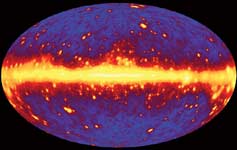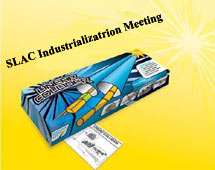

Thursday - April 27, 2006
SLAC Today is
available online at:
http://today.slac.stanford.edu
In this issue:
GLAST Telescope Components to be Tested at CERN
Science Today: The Rarest B Decay
Planned Isobutane Flare
Linear Collider Industrial Forum Comes to SLAC
 |
 |
|
Thursday - April 27, 2006 |

GLAST's Large Area Telescope will view the universe in gamma ray photons, allowing researchers to
create images like the simulated one shown above. In order to create these maps accurately,
the telescope will need to be well-calibrated.
GLAST Telescope Components
|
||||||||||||||||||||||||||
|
|
||||||||||||||||||||||||||
 The Rarest B Decay
As the PEP-II accelerator creates ever increasing numbers of electron-positron collisions, BaBar experimenters are exploiting the large data sample to search for exceedingly rare particle reactions which could potentially reveal the existence of new spacetime dimensions and symmetries. In a paper recently submitted to Physical Review, BaBar researchers describe the latest measurements of the rarest B meson reaction ever observed: a B meson decaying into a K meson and a pair of charged leptons (electrons or muons). The B meson, which is composed of a "bottom" quark and a light anti-quark, is prolifically produced by PEP-II, and out of the 500 million B mesons recorded by the BaBar detector, only 50 of these rare decay events were found. BaBar researchers relied on excellent particle identification by the detector, multivariate background discrimination methods, a "blind" analysis technique, and plenty of data to accomplish this needle-in-a-haystack feat. The motivation for their search was to study how a bottom species of quark can change into a "strange" quark species, which in the Standard Model theory can only proceed via a rare "penguin diagram" loop of virtual high-energy particles. New dimensions of spacetime, or new spacetime symmetries, such as supersymmetry, could dramatically modify this prediction, changing the decay rate or the angular orientation of the decay products. The standard theory was found to be consistent with the BaBar results, which highly constrains how supersymmetry or extra dimensions could be realized in nature. However, with only small samples currently in hand, there is plenty of room for even stronger tests of these new phenomena as BaBar plans to accumulate billions of B mesons through 2008. |
Planned Isobutane Flare
SLAC is making way for LCLS construction. Part of this effort is the removal of a 30-foot isobutane tank located on the SLAC Large Detector gas pad near Building 750. Isobutane is a flammable gas that must be managed in a safe manner to prevent a fire hazard or even an explosion. Working with HAAS- TCM, SLAC's chemical service provider, and two sub-contractors that specialize in this type of work, Chemical and General Safety (CGS) and Conventional and Experimental Facilities (CEF) have partnered to remove this tank. The first step was burning off any remaining Isobutane using a torch placed a safe distance away from the tank and any combustible material. The tank will now be purged multiple times using an inert gas and then filled with water. After the tank is empty and clean it will be sent off site to a metal recycler. Linear Collider Industrial Forum Comes to SLAC
The Linear Collider Forum of America (LCFOA) will hold its Spring 2006 meeting at SLAC on May 1-2. The LCFOA is an organization of manufacturers and civil construction firms that support the ILC and are interested in participating in its construction. They keep up to date with R&D developments through semi-annual meetings such as this one. The LCFOA provides a partnership between its industry members and the government, National Laboratories, universities, the ILC Global Design Effort (GDE) and the Americas Regional Team supporting the GDE throughout all phases of the ILC program. Read more... |
Events (see all | submit)
Access (see all)
Announcements
|
||||||||||||||||||||||||
| | ||||||||||||||||||||||||||
What's Cookin' at the Linear Cafe (see weekly menu)
|
||||||||||||||||||||||||||
|
|
||||||||||||||||||||||||||
 <%
Response.AddHeader "Last-modified", getArticleDate()
'Response.AddHeader "Last-modified","Mon, 01 Sep 1997 01:03:33 GMT"
'Monday, December 06, 2010
%>
<%
Response.AddHeader "Last-modified", getArticleDate()
'Response.AddHeader "Last-modified","Mon, 01 Sep 1997 01:03:33 GMT"
'Monday, December 06, 2010
%>View online at http://today.slac.stanford.edu/. |
||||||||||||||||||||||||||